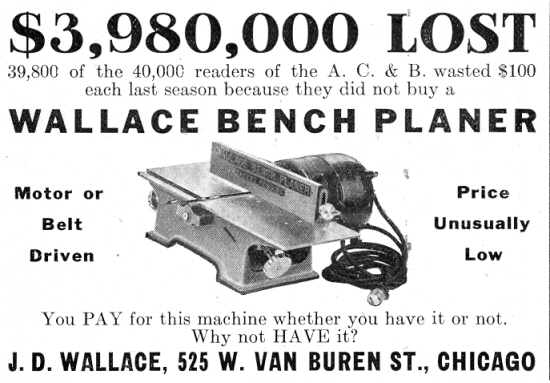In 1914, John D. Wallace of Chicago began making a 4" jointer plus kits for high school shop projects. The business was formally registered as J. D. Wallace on October 27, 1916. By 1919 the name had become J. D. Wallace & Co. Early ads show the jointer, plus kits for a gas engine and a benchtop metal lathe with cylindrical bed. In 1919 Wallace introduced a 14-inch direct-drive bandsaw, which was the first home-shop motorized bandsaw.
Wallace quickly added other (pre-built) machines to his lineup, including table saws, scroll saws, drills, combination machines, and a 16-inch version of their bandsaw. The machines were small but solidly built, and represent the first line of motor-driven woodworking machines designed for home-shop use.

Advertisement from the November 1915 "American Carpenter & Builder"
Wallace's early claim to fame was the "Portable" line, which did not suggest light weight so much as that they were driven by a dedicated motor rather than a line shaft; the "Portable" hollow chisel mortiser, for example, weighed about 500 pounds. Wood Working Digest 1955-56 Directory hints that the Portable line was introduced in 1918. There was also a "Workace" line consisting of smaller machines with a motor that could be moved from one machine to another.
By the 1940s the company had fallen on hard times. A 1941 ad shows a tablesaw that looks sadly outdated in comparison to machines from other makers such as Delta, Oliver, and Crescent. The company was acquired at some point after 1941 by Union Tool Co. of Warsaw, Indiana. The ownership changed at least once more before the business was formally dissolved on December 4, 1957.
There was some relationship between Wallace and Solem Machine Co., possibly an OEM agreement.
Establishing the Born-on Date of Wallace Machines
The Photo Index sorted by serial number may provide some help in translating your Wallace serial number into an approximate date. You should not assume that the dates assigned by the various contributors are always accurate.
The company name provides some clues as well. Machines labeled simply as "J. D. Wallace" are likely from before 1919. Machines labeled as "J. D. Wallace & Co." are from 1919 or later.
Some labels include the company's street address. In 1914 the company was located at 527 West Van Buren Street, Chicago. By 1916 the location was 1401-1409 West Jackson Boulevard. In September 1925 the location changed to 134-158 South California Avenue.
Finally, the product model can also help in assigning an approximate date to your machine. The Portable line was introduced in 1918. The Workace line was introduced in about 1929. Individual models were can be assigned more specific dates; check out the catalogs and ads under the "Publications" and "Images" tabs, respectively.
Information sources
- A contributor to the late Ray McInnis' now-defunct WoodworkingHistory.com, Michael Tavalin, did some research quoted in their chapter on technological development 1911-1920. The referenced sources include Industrial Arts magazine for 18 September 1929, and the Illinois Secretary of State Office, Archives Reference Section (Springfield Office).
- Information on company location was culled from various ads and articles found through Google Books. Mentions from 1921 through 1925 used the address 1401 W. Jackson Blvd (or 1403, or 1407, up to 1417; the different numbers were sometimes used so that the company could track which ads were most successful). In 1925 the ads switched to 134 S. California Ave. (or 136, or any other even number up to 158). Until the end of the 1930s the address was sometimes given as "Adams St. at California Ave." or "Wilcox and California Ave."
- An ad in a 1915 issue of Carpenter and Builder gives the name simply as "J. D. Wallace." The ad features their portable jointer, which was 18" long and weighed only 50 pounds, including motor, it appears to be 6" wide.
- November 1915 issue of American Carpenter and Builder.
- 20-page 1933 catalog for the Workace line.
- Ad in November 1941 issue of Industrial Arts and Vocational Education.
- Correspondent John Kraucunas provided the following.
My father worked for the JD Wallace Co. in Chicago in WWII. They had a wartime contract to fabricate air craft landing gear. Dad was a certified welder, then things got slow the older guys trained him on the lathe, shaper, and mill. I am just now cleaning out his machinist tool box, and have several JD Wallace tin name plates/id plates. I also have an electric saw motor dad put a grinding wheel on. When the war was over the contracts ran out and people were being laid off. In the box is a time sheet to dad from the JD Wallace Co. dated 1946, and a time off sheet of August 1945. Also his workers ID badge. He thought they were going out of business when he left Chicago in 1947, I read otherwise in the info here.
- An owwm.org forum discussion alerted us to the existence of a cylindrical-bed metal lathe with J. D. Wallace & Co. cast into the headstock. This lathe is a copy of a design from English maker Drummond Brothers, Ltd.; since this lathe was provided as a kit by Wallace before he incorporated, it seems unlikely that the design was licensed from Drummond. Not very many of the Wallace lathes could have been sold because we have only seen that one example. An advertisement in the October 1916 Industrial Arts features their kit for this lathe.